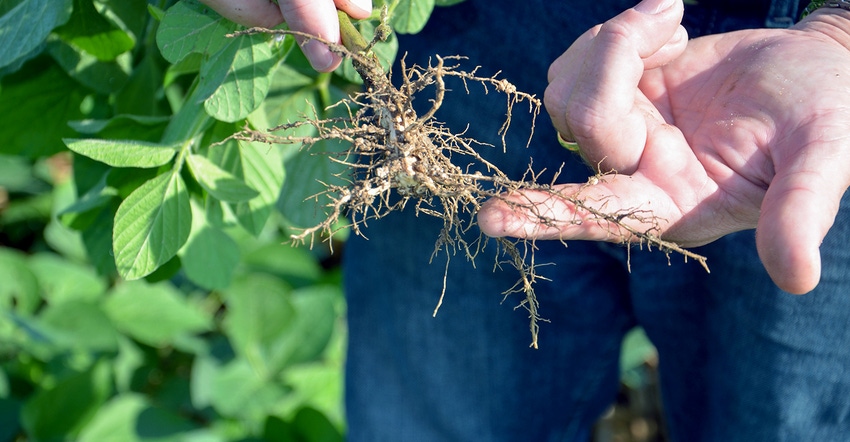
Soybeans leave about 30 pounds of nitrogen behind for corn to use. That means you can reduce the nitrogen rate for corn by 30 pounds per acre. If you were going to apply 180 pounds, you can cut that back to 150 pounds. Everyone knows these statements are correct, right? It’s what generations of agronomists have taught farmers, and what farmers have taught their children.
Hold on! Based on more recent information about how soybeans use nitrogen, and the push toward 80- to 100-bushel soybean yields, Steve Gauck isn’t so sure. In fact, Gauck, a sales agronomist for Beck’s based near Greensburg, Ind., thinks there are several unanswered questions about nitrogen and soybeans once you push beyond 50 to 60 bushels per acre.
Nitrogen requirements
Recent information indicates that soybeans need 4.5 to 5 pounds of nitrogen per bushel produced. So a 100-bushel-per-acre soybean crop would need 450 to 500 pounds of nitrogen. Common knowledge that rhizobium bacteria live on soybean roots and fix nitrogen from the air is still true, Gauck says. He estimates that this process typically produces about enough nitrogen to grow 50 to 60 bushels of soybeans per acre. That’s roughly 70% of what a high-yield crop needs.
“Is this one reason why some people have hit a ceiling at 55 to 60 bushels per acre?” Gauck asks. It’s not an easy question to answer.
So when soybeans make more than 60 bushels per acre, where do they get the extra nitrogen? “If they produce 100 bushels per acre, they’re pulling about 200 pounds out of the soil,” Gauck says.
It’s a different way to think about soil fertility and high-yield soybeans, he notes. “Beck’s Practical Farm Research plots indicate that the nitrogen rate of commercial fertilizer for corn is 180 pounds per acre after soybeans,” he adds. “It’s not 150, taking credit for nitrogen produced by soybeans.
“If you’re raising 70 to 80 bushels per acre of soybeans and still taking the N credit, try applying the extra 30 pounds per acre of N for corn in a couple of fields and see what happens,” he suggests.
Tricky nutrient
Knowing high-yield soybeans use more nitrogen doesn’t mean it’s easy to know how to get more nitrogen to them, Gauck acknowledges. Years of starter fertilizer research on soybeans in PFR plots have been inconsistent.
Some people report applying N over soybeans around the R4 stage to try to supply nitrogen as nodule activity trails off. Results have been inconsistent in that scenario, too.
“Some people think nitrogen needs to go on earlier, maybe at R2 or R3,” Gauck says. “There’s also the risk that if you put on too much nitrogen, plants will lodge and yield less. We don’t have all the answers. What we do know is that we need to think about soil fertility and nitrogen in soybeans differently as we move into higher-yielding soybeans.”
About the Author(s)
You May Also Like




